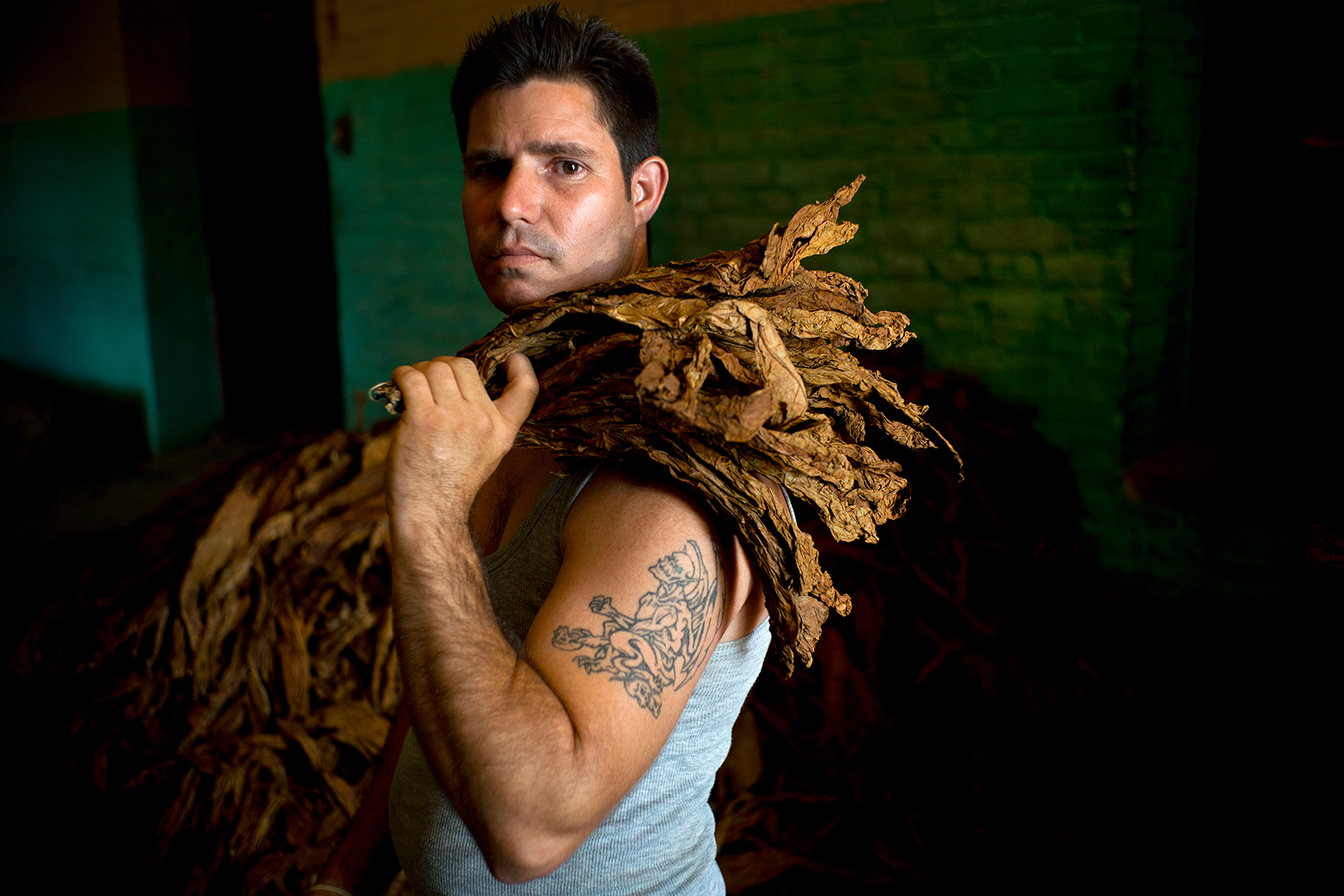Cuban tobacco farmers celebrate a bumper crop

Cuba's tobacco farmers are celebrating a bumper crop after two bad years that coincided with a boom in demand set off by a surge of tourists and looser U.S. rules on cigar-buying.
One night of rain combined with a winter chill can ruin a tobacco crop, leaving farmers nervous until the growing season has ended and the harvest has begun. This spring, the fields in Pinar del Rio Province, some 90 miles (150 kilometers) west of Havana, are carpeted with healthy green tobacco plants.
"This year I can't complain," farmer Luis Martinez says. "The weather helped the harvest and I think it'll be the best crop in many years."
Sales of Cuban cigars topped $430 million in 2016, with demand increasing both nationally and worldwide.
Cruise ship tourists, U.S. visitors and others are snapping up boxes of cigars in stores around the country. The Obama administration last year made it legal for travelers to bring unlimited quantities of rum and cigars back to the U.S.
Distributors abroad are also reporting record sales in an important source of foreign revenue for the cash-strapped government.

In this Feb. 28, 2017 photo, tobacco farm owner Luis Martinez watches as a worker clears the ground of lose tobacco leaves in Cuba's western province Pinar del Rio. "This year I can't complain," Martinez says. "The weather helped the harvest and I think it'll be the best crop in many years." (AP Photo/Ramon Espinosa)

In this Feb. 28, 2017 photo, students pass through on a dirt road flanked by tobacco fields in Cuba's western province Pinar del Rio. This spring, the fields in the province some 90 miles (150 kilometers) west of Havana are carpeted with healthy green tobacco plants. (AP Photo/Ramon Espinosa)

In this Feb. 28, 2017 photo, farm hand Jorge Luis Leon Becerra uses a plow powered by oxen over an area where tobacco plants were recently harvested, at the Martinez tobacco farm in Cuba's western province Pinar del Rio, Cuba. Soaking rains that came too early, followed by drought conditions essentially wiped out last year's crop, following on the heels of bad yields in the previous year. (AP Photo/Ramon Espinosa)

In this Feb. 28, 2017 photo, tobacco picker Romerio Garcia collects leaves at the Alfredo Rojas farm in Vinales, Cuba's western province Pinar del Rio. This year, officials and farmers say, will prove to be a bumper crop of tobacco for the island, with yields from the country's tobacco plantations in the north showing healthy gains.(AP Photo/Ramon Espinosa)

In this Feb. 28, 2017 photo, tobacco picker Romerio Garcia collects leaves at the Alfredo Rojas farm in Viñales, Cuba's western province Pinar del Rio. The lush green fields are carpeted with healthy tobacco plants. One cooperative foreman says his workers have harvested three or four times what they were able to bring in last year. (AP Photo/Ramon Espinosa)

In this Feb. 28, 2017 photo, a tobacco picker moves freshly harvested tobacco leaves to a drying shed at the Martinez tobacco farm in Cuba's western province Pinar del Rio. The drying sheds are full of tobacco leaves, waiting for the moment when they are transformed into hard currency for the country, a welcome development for Cuba's ailing economy.(AP Photo/Ramon Espinosa)

In this Feb. 28, 2017 photo, a picker collects tobacco leaves at the Martinez farm in Cuba's western province Pinar del Rio. Cuban tobacco farmers are celebrating a bumper crop after two bad years that coincided with a boom in demand set off by a surge of tourists and looser U.S. rules on cigar-buying. (AP Photo/Ramon Espinosa)

In this Feb. 28, 2017 photo, a tobacco worker takes his daughter to school on horseback in Cuba's western province Pinar del Rio. Despite the flood of visitors since Cuba and the U.S. reestablished relations, some aspects of life in the provinces have changed little. (AP Photo/Ramon Espinosa)

In this Feb. 28, 2017 photo, tobacco curers play cards and video games during a work break at a state-run warehouse in San Luis, Cuba's western province of Pinar del Rio. Workers say they're eager to see more benefits of Cuba's increasing links to the outside world since the start of new relations with U.S., without losing the placid lifestyle of the last half-century. (AP Photo/Ramon Espinosa)

In this Feb. 28, 2017 photo, despalilladoras, who remove the central vein from tobacco leaves, take a work break, inside a state-run warehouse in San Luis, in Cuba's western province of Pinar del Rio. Cuban officials say this year's tobacco harvest will far surpass the last two years' yield, ending what had been a potentially disastrous shortfall in production at a time of soaring worldwide demand for the country's popular cigars. (AP Photo/Ramon Espinosa)

In this Feb. 28, 2017 photo, a worker hangs tobacco leaves in a drying shed, at the Martinez tobacco farm in Cuba's western province Pinar del Rio. The tobacco leaves will be hung to dry for almost two months before being sent off for cleaning and eventually rolled into cigars. (AP Photo/Ramon Espinosa)

In this Feb. 28, 2017 photo, images of the late leader Fidel Castro, revolutionary hero Ernesto "Che" Guevara, and tobacco farm scenes, decorate a wall inside a state-run "drying room" where tobacco curers take a work break in San Luis, Cuba's western province Pinar del Rio, Cuba. The drying sheds are full of tobacco leaves, waiting for the moment when they are transformed into hard currency for the country, a welcome development for Cuba's ailing economy. (AP Photo/Ramon Espinosa)

In this Feb. 28, 2017 photo, a worker removes fermented tobacco leaves from a box in preparation for the "breathing" stage, at a state-run warehouse in San Luis, in Cuba's western province of Pinar del Rio. Depending on the leaf, tobacco is left to "breath" in a dark space from anywhere between two months to several years. (AP Photo/Ramon Espinosa)

In this Feb. 11, 2017 photo, workers who are responsible for handling freshly cut tobacco leaves, change into their street clothes at the end of their work shift at a state-run warehouse in Alquizar, in Cuba's western province Artemisa. (AP Photo/Ramon Espinosa)

In this Feb. 28, 2017 photo, a "despalilladora" removes the central vein from a tobacco leaf inside a state-run warehouse in San Luis, in Cuba's western province Pinar del Rio. After the central vein is removed from each dried leaf, they're dipped in ammonium and water and dried again for at least two months. (AP Photo/Ramon Espinosa)

Rollers make cigars at La Corona cigar factory in Havana, Cuba, Thursday, March 2, 2017. Cuban officials say this year's tobacco harvest will far surpass the last two years' yield, ending what had been a potentially disastrous shortfall in production at a time of soaring worldwide demand for the country's popular cigars. (AP Photo/Ramon Espinosa)

A roller puffs on a cigar while working at La Corona cigar factory in Havana, Cuba, March 2, 2017. Exports of Cuban stogies reached more than 430 million US dollars per year in 2016, with demand increasing both nationally and worldwide. (AP Photo/Ramon Espinosa)

A sorter selects cigars at the H. Upmann cigar factory in Havana, Cuba, Thursday, March 2, 2017. Distributors abroad are reporting record sales, making cigar sales an important source of foreign revenue for the cash-strapped government. (AP Photo/Ramon Espinosa)

Rollers making cigars are reflected in a framed image of the late Cuban leader Fidel Castro at La Corona cigar factory in Havana, Cuba, Thursday, March 2, 2017. Exports of Cuban stogies reached more than 430 million US dollars per year in 2016, with demand increasing both nationally and worldwide. (AP Photo/Ramon Espinosa)
Text from AP news story, Cuban tobacco farmers celebrate a bumper crop.
Photos by Ramon Espinosa
See these photos on APImages
Follow AP photographers on Twitter
Written content on this site is not created by the editorial department of AP, unless otherwise noted.





